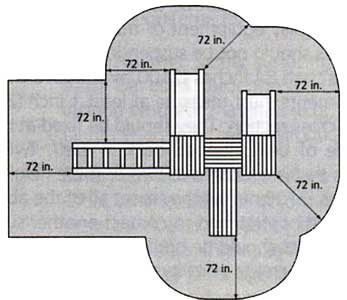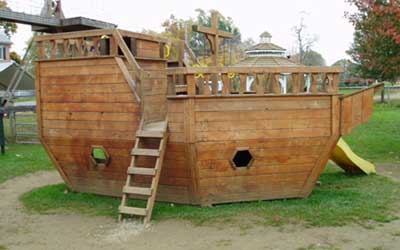Children's Play Area Safety Additional information & resources
© 2005 White Hutchinson Leisure & Learning Group
Click here to go to original Children's Play Area Safety article
80% of all playground injuries are caused by falls. Falls are especially dangerous for young children, as their heads are larger in proportion to their bodies. Accordingly, young children have higher centers of gravity, which typically causes them to fall head first. Head injuries can be serious and result in death (about 12 children a year die from playground injuries). Therefore it is important that:
- playground equipment not allow children to get higher than what is known as the "critical height" - the height above which life-threatening head injuries can be expected to occur, and
- playground equipment be above and surrounded by protective shock absorbing surfacing to reduce the seriousness of injury from falls.
Both the U.S. Consumer Product Safety Commission (CPSC) Handbook for Public Playground Safety and the ASTM (American Society for Testing and Materials) Standard Consumer Safety Performance Specification for Playground Equipment for Public Use set forth maximum heights for areas of playground equipment from which children can fall, require protective safety surfacing contain many more requirements.
Since younger children have poorer coordination and balance are more vulnerable to injury than school-age children, guardrails or protective barriers are required for elevated surfaces that are more than 20 inches above the protective surfacing. For school-age children, the standard is more than 30 inches.
Generally, protective safety surfacing is required under equipment and extending 6 feet out from the perimeter of the equipment (the requirements for swings are more extensive).

If the play surfaces on either of two adjacent play structures exceed 30", adjacent play equipment must be separated by 9 feet.
The U.S. Americans with Disabilities Act (ADA), a Federal law, requires that all playgrounds be accessible to children with disabilities (this includes agritainment facilities). This includes access to the playground equipment by children with disabilities. Although in the past, pea gravel, sand and wood chips were considered acceptable safety surfacing, this ADA requirement limits permitted safety surfacing to engineered wood fiber, rubber tiles, poured-in-place rubberized surfacing and rubberized matting. Engineered wood fiber is the least expensive and needs to be minimum depth of 12 inches.
CPSC recommends that equipment for preschool children be age appropriate, appropriately sized and separated from equipment for grade-school children. Many playground injuries involve children four and younger playing on equipment designed for older children.
Swings in unsupervised play areas are considered unsafe, especially for young children. Young children do not understand the concept of cause and effect, so they are often injured by walking in front of a child who is swinging. Swings should always be placed at the back of a play area away from any paths children would take in the play areas
In our work with agritainment facilities, we constantly see playground equipment that fails to meet CPSC and ASTM requirements, the lack of safety surfacing and failure to zone younger children's equipment from grade-school age equipment. One of the big problems we see is the use of non-commercial playground equipment - residential type playground equipment - that does not meet CPSC and ASTM standards. One example of unsafe play equipment is shown below.

Example of non-commercial children's playground equipment that fails
to meet many CPSC and ASTM safety standards for public playgrounds.
In agritainment facilities, farmers often construct their own equipment, such as slides and also create play areas using hay and other materials. In some situations, such as hay play areas, it is hard to know how to follow design the area following CPSC and ASTM guidelines. More importantly is not to create high areas that children can fall from and to have protective safety surfacing in the area extending 6 feet out from the perimeter of all equipment or play creations higher than 20". These two safety pre-cautions should minimize the severity of injuries if children do fall. Straw itself should never be relied on to provide protective shock absorption.
We encourage you to download and follow the CPSC Guidelines for all play areas and to only purchase playground equipment designed for public use that meet all CPSC and ASTM standards. Also make sure check if your state has enacted any playground laws and regulations.
Resources:
- Creating Safe Play Areas on Farms (908 kb PDF file) - a guidance document on features of safe play areas for children who live on or visit farms, ranches, orchards or other agricultural settings.
- CPSC Handbook for Public Playground Safety (3.7 mg PDF file)
- A Guide to the ADA Accessibility Guidelines for Play Areas
- Zeager Bros. Inc. - national suppliers of engineered wood fiber safety surfacing they brand as Woodcarpet.
- National Program for Playground Safety - good general resource site
- Outdoor Play & Learning Environments: Returning to Nature
- National
Safety Council, Playground Safety


